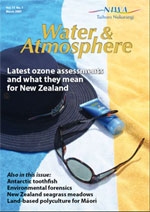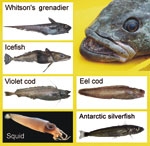PDF of this article (233 KB)



Matt Pinkerton, Stuart Hanchet, and Janet Bradford-Grieve have been piecing together the puzzle of Antarctic ecology to understand the potential effects of fishing for Antarctic toothfish.
The icy waters of Antarctica support unique and complex marine ecosystems. Visitors to the white continent have long been spurred by the twin passions of profit and science; in the 19th and 20th centuries, sealing and whaling had huge impacts on the Antarctic and Ross Sea ecosystems. Until recently, the Ross Sea was one of the last productive continental shelf and slope areas in the world not targeted by commercial fishing, apart from some exploratory fishing by the Soviet trawler fleet during the 1970s. Over the last few years, however, the Ross Sea has become a long-line fishing ground for Antarctic toothfish (Dissostichus mawsoni).
Antarctic finfish resources are managed by CCAMLR, the Convention for the Conservation of Antarctic Marine Living Resources, which strongly recognises the need to balance exploitation with conservation. Maintaining this balance in the Ross Sea is difficult, and requires a better understanding of the ecosystem effects of fishing there.
A precautionary model predicts that fishing to date may have reduced the toothfish stock to about 85% of its unfished level. The current CCAMLR rules allow for a long-term reduction of up to 50% over the next 35 years.
Research at NIWA aims to use available information to understand the potential effects on the Ross Sea ecosystem of fishing Antarctic toothfish. In collaboration with international colleagues, we have been pulling together pieces of the Ross Sea ecosystem puzzle from diverse sources of information. We’ve perused the wealth of international literature on the Antarctic, and from work we are increasing our understanding of how this ecosystem fits together. We’re developing a trophic model for the Ross Sea to determine the role of the Antarctic toothfish in this ecosystem. A preliminary version of this ‘mass balance’ model shows the huge variation in productivity of organisms in the system.
How does fishing change an ecosystem?
Species within an ecosystem are interconnected in many ways, and one of the most significant is by one species feeding on another – the trophic relationship. Reducing the abundance of one species by fishing can have immediate effects on the system through these trophic connections. At the simplest level, removing Antarctic toothfish from the Ross Sea reduces food available to its predators. This is known as a first-order effect: the fishing affects species one trophic connection away from the target species.
Effects on predators
The main natural predators of Antarctic toothfish in the Ross Sea (depending on the size of the toothfish) are sperm whales, type-C killer whales, Weddell seals, and, possibly, large squid. New Zealand, US, Italian, and other international scientists, working primarily from shore bases, have provided insights into the biology and ecology of shore-based predators along the western edge of the Ross Sea. However, there has been very limited offshore work, so there are large gaps in our knowledge of all species in the mid Ross Sea shelf, and particularly on the slope where large toothfish are found and the fishery is focused. We don’t know, for example, if killer whales stay in the Ross Sea year round, or leave in winter, and whether they breed in the region.
From our modelling and from international work using chemical markers, analysis of seal scats, and seal-mounted video cameras, it appears that Antarctic toothfish are unlikely to make up a large part of the diets of their predators on an annual basis. At an ecosystem level, there are not enough toothfish to keep any of the predator populations supplied with food. However, potentially important localised effects remain to be investigated. For example, the consumption of toothfish in particular locations, at particular times of the year, or by particular parts of the predator populations, may still be important.
Effects on prey
Removing a predator from a system can also significantly affect the animals lower down the food chain. Antarctic toothfish feed on a wide range of prey but are primarily piscivorous (fish-eating). In coastal waters around McMurdo Sound, where smaller, younger toothfish tend to live, adults feed principally on the ubiquitous Antarctic silverfish (Pleuragramma antarcticum). As the toothfish get older, they tend to move north and offshore, where they feed on deepwater demersal (bottom-dwelling) fish such as Whitson’s grenadier (Macrourus whitsoni), icefish (Chionobathyscus dewitti), eel cods (Muraenolepis spp.), violet cod (Antimora rostrata), and squid.
Changes to the predation of toothfish on these fish prey species may have wide-ranging effects on other species through ‘second-order effects’, including trophic cascades, and the keystone predator effect. A trophic cascade happens when a reduction in predator numbers leads to increased abundance of its prey, putting pressure, in turn, on their food sources. In other systems, keystone predators maintain biodiversity by preferentially consuming competitively dominant prey species. If predation by keystone predators is reduced, abundance of some prey species can increase to levels where they start to exclude subordinate competitors.
Research shows that these second-order effects are difficult to predict. In addition, the numbers of these demersal fish in the Ross Sea are very poorly known. Any impact on organisms in the middle trophic levels – especially Antarctic silverfish – could damage the whole ecosystem because Antarctic silverfish are key links between primary producers and higher predators in the Ross Sea: they figure in the diets of almost all Ross Sea predators, including penguins, seals, whales, Antarctic toothfish, and other demersal fish.
Fitting more pieces of the puzzle
The literature review and preliminary work on the trophic model have allowed us to identify major information gaps. We plan to fill some of these gaps through fieldwork in the Ross Sea and work with international colleagues. We’re getting acoustic data and biological specimens from fishing vessels now and in future years.
Determining potential ecosystem effects hinges on understanding the distribution and abundance of demersal fish and Antarctic silverfish in the Ross Sea shelf and slope. This will be a priority for future fieldwork, for example, during the proposed multidisciplinary research voyage by RV Tangaroa during the International Polar Year in 2007/08. We are well placed to learn more about the biomass and distribution of the main Ross Sea middle trophic species: Tangaroa is fitted out to survey these species acoustically and to sample using a variety of gear, including plankton nets, young-fish trawls, midwater and demersal fish trawls, and video cameras.
Brushing up on toothfish
- Although CCAMLR sanctions fishing for toothfish in the Antarctic, how this affects the Ross Sea ecosystem is not known.
- Toothfish are both prey and predator, and reducing their numbers could affect the food chain in both directions.
- NIWA scientists are modelling food and feeding relationships in the Ross Sea based on previous research and ongoing sampling.
Further reading
Hanchet, S.; Judd, W. (2006). The Ross Sea toothfish fishery. New Zealand Geographic 79: 16–20.
Knox, G.A. (1994). The biology of the Southern Ocean. Cambridge University Press, Cambridge. 444 p.
Scott, M. (1991). Antarctica, a New Zealand perspective. New Zealand Geographic 9: 52–83.
Waterhouse, E.J. (ed.) (2001). Ross Sea region 2001: A state of the environment report for the Ross Sea region of Antarctic. New Zealand Antarctic Institute, Christchurch. 265 p.
Dr Matt Pinkerton is a specialist in remote sensing and trophic modelling, and Dr Janet Bradford-Grieve is a marine biologist and ecologist. They are based at NIWA in Wellington. Dr Stuart Hanchet is a fisheries scientist based at NIWA in Nelson.
This project is supported by the Ministry of Fisheries programme on ‘Ecosystem Effects of Fishing in the Ross Sea’, and the Foundation for Research, Science and Technology ‘Ross Sea Sustainability’ programme.
Teachers’ resource for NCEA Achievement Standards or Unit Standards: Biology Level 1 US18970, AS90162, Level 2 AS90461, AS90769 Science Level 1 AS90187, Level 2 AS90177 See other curriculum connections at www.niwa.co.nz/pubs/wa/resources
